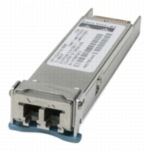Cisco 10GBASE Dense Wavelength-Division Multiplexing XFP Module
Product Overview
The Cisco Dense Wavelength-Division Multiplexing (DWDM) XFP pluggable module (Figure 1) allows enterprise companies and service providers to provide scalable and easy-to-deploy 10 Gigabit Ethernet services in their networks.
Figure 1. Cisco DWDM XFP Module

Main features of the Cisco DWDM XFP include:
• The Cisco DWDM XFP supports 10GBASE Ethernet.
• The hot-swappable input/output device plugs into an Ethernet XFP port of a Cisco switch or router to link the port with the network.
• The Cisco DWDM XFP supports the Cisco quality identification (ID) feature, which enables a Cisco switch or router to identify whether or not the module is an XFP module certified and tested by Cisco.
• The Cisco DWDM XFP supports 32 nontunable ITU 100-GHz wavelengths compatible with the Cisco ONS DWDM(7300-NSE-100) channel plan.
• The Cisco DWDM XFP supports digital optical monitoring capability.
Platform Support
The Cisco DWDM XFPs are supported across a variety of Cisco switches, routers, and optical transport devices. For more details, refer to the Cisco wavelength-division multiplexing transceivers compatibility matrix
Connectors and Cabling
• Equipment: standard XFP interface
• Network: dual LC/PC connector
Note: Only connections with patch cords with PC or UPC connectors are supported. Patch cords with APC connectors are not supported. All cables and cable assemblies used must be compliant with the standards specified in the standards section.
Dimensions
• Dimensions (L x W x H): 71 x 18.5 x 8.5 mm. Cisco XFPs typically weigh less than 300 grams.
• Environmental Conditions and Power Requirements
• Operating temperature range: 32 to 158°F (0 to 70°C)
• Storage temperature range: -40 to 185°F (-40 to 85°C)
• The maximum power consumption per Cisco XFP module is 3.5W.
No comments:
Post a Comment